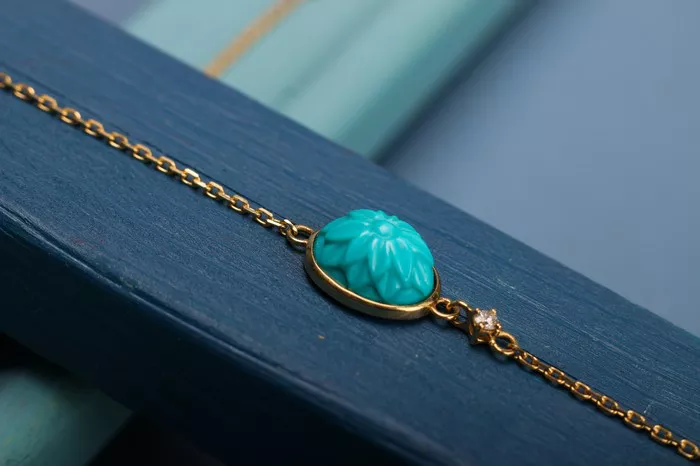Turquoise has been cherished for thousands of years, not only for its beauty but also for its purported metaphysical properties. Among the many varieties of turquoise, Dry Creek Turquoise stands out due to its unique and captivating pale blue to white color. However, as with any prized gemstone, there are numerous imitations on the market. Knowing how to distinguish real Dry Creek Turquoise from fake ones is essential for collectors and enthusiasts. This article will guide you through the key aspects of identifying genuine Dry Creek Turquoise.
Understanding Dry Creek Turquoise
Origin and Characteristics
Dry Creek Turquoise is mined from the Dry Creek Mine near Battle Mountain in Nevada. This turquoise is renowned for its light blue to white coloration, which is distinct from the more common vibrant blue or green hues of other turquoises. The pale color results from the low copper content in the stone, which typically imparts the blue color to turquoise.
Key characteristics of Dry Creek Turquoise include:
Color: Pale blue to white.
Matrix: Often features a light brown to golden matrix, sometimes in a spider web pattern.
Texture: It has a naturally dense and hard composition.
Historical Significance
Dry Creek Turquoise has been used by Native American tribes for centuries, particularly the Shoshone and Paiute tribes. Its unique appearance made it highly valued for jewelry and ceremonial purposes. Understanding the historical and cultural significance of Dry Creek Turquoise adds an additional layer of appreciation and respect for this beautiful gemstone.
Common Imitations and How They Are Made
Howlite and Magnesite
Howlite and magnesite are two of the most common materials used to imitate Dry Creek Turquoise. These stones are naturally white or colorless and can be dyed to mimic the pale blue hues of Dry Creek Turquoise.
Howlite: A soft mineral, which is easy to carve and dye.
Magnesite: Another soft mineral, similar to howlite, often used in low-quality imitations.
Resin and Plastic
Some imitations are made from resin or plastic. These materials are molded and dyed to replicate the appearance of Dry Creek Turquoise but lack the natural patterns and hardness of the real stone.
Reconstituted Turquoise
Reconstituted turquoise involves grinding up low-quality turquoise or turquoise dust, mixing it with a binding agent, and then forming it into blocks. These blocks are then cut and polished to resemble natural turquoise.
Physical Examination Techniques
Visual Inspection
The first step in identifying genuine Dry Creek Turquoise is a thorough visual inspection.
Color Consistency: Real Dry Creek Turquoise will have a more natural variation in color. Dyed howlite or magnesite may have a more uniform and unnatural hue.
Matrix Patterns: Genuine stones often display a distinctive matrix, which is difficult to replicate in imitations. Look for the characteristic light brown to golden spider web patterns.
Surface Texture
Feel: Real Dry Creek Turquoise has a cool, smooth feel. Plastic or resin imitations may feel warmer and lighter.
Porosity: Real turquoise is slightly porous. Dyed stones or resins often have a more even surface with fewer natural
imperfections.
Weight
Real Dry Creek Turquoise is denser and heavier than plastic or resin imitations. Comparing the weight of the stone to a known genuine sample can help in identification.
See Also: Is Persian Turquoise Valuable?
Advanced Identification Methods
Magnification
Using a jeweler’s loupe or microscope can reveal more details.
Inclusions: Real Dry Creek Turquoise may have natural inclusions that are not present in imitations.
Matrix Detail: The intricate details of the matrix are more visible under magnification.
UV Light Examination
Real turquoise may fluoresce under UV light, while many imitations do not. This test can help distinguish between genuine and fake stones.
Hardness Test
Turquoise has a Mohs hardness of 5-6. Testing the hardness can help identify imitations, as howlite and magnesite are softer (around 3.5 on the Mohs scale), and resins or plastics are even softer.
Chemical Tests
Acetone Test
Applying a small amount of acetone to the stone can reveal whether it has been dyed. If the color comes off, it is likely an imitation.
Acid Test
Turquoise is sensitive to acids. A drop of diluted hydrochloric acid can cause genuine turquoise to fizz slightly, while imitations might not react.
Professional Evaluation
Gemological Laboratories
For definitive identification, submitting the stone to a gemological laboratory for analysis is recommended. These labs have the tools and expertise to accurately determine the authenticity of Dry Creek Turquoise.
X-Ray Diffraction (XRD)
XRD can identify the crystal structure of the stone, confirming whether it is genuine turquoise or an imitation.
Infrared Spectroscopy (IR)
IR spectroscopy can reveal the chemical composition of the stone, further confirming its authenticity.
Buying Tips for Authentic Dry Creek Turquoise
Reputable Dealers
Certified Dealers: Buy from dealers who provide certification and have a reputation for selling authentic gemstones.
Documentation: Ensure the stone comes with proper documentation detailing its origin and authenticity.
Price Consideration
Genuine Dry Creek Turquoise is rare and thus more expensive. Be wary of prices that seem too good to be true, as they often indicate imitations.
Ask for Guarantees
Reputable dealers will often offer a guarantee or return policy if the stone is found to be an imitation. This provides added security for your purchase.
Conclusion
Spotting real Dry Creek Turquoise from imitations requires a keen eye and knowledge of the stone’s unique characteristics. By understanding the common types of imitations and utilizing physical, chemical, and professional evaluation methods, you can confidently identify genuine Dry Creek Turquoise. Always buy from reputable sources and seek professional verification when in doubt. Appreciating the beauty and rarity of authentic Dry Creek Turquoise enhances its value and ensures you are investing in a truly special gemstone.


